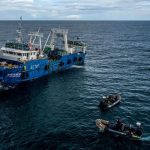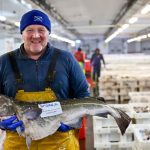Fisheries Minister Jim Anderton today increased the catch limits for the rock lobster (crayfish) and southern blue whiting fisheries in the waters around southern New Zealand.
The increase in rock lobster catches are worth an estimated $11.5 million a year to fishers while the increase in the southern blue whiting catch are worth an estimated $4.7 million a year. (Approximate figures calculated from average export prices)
Jim Anderton also adjusted deemed value rates (charges that are imposed on commercial fishers to discourage catching in excess of their catch entitlement) for 28 fish-stocks.
Both the increased catch limits and the amended deemed values will take effect on 1 April 2008.
Rock Lobster
Catch limits in the CRA8 fishery (Southland) are to increase by nearly 211 tonnes to 1053 tonnes and in the CRA7 (Otago) fishery by 3.7 tonnes to 143.9 tonnes.
The increases this year follow increases both in 2004 and 2006, and are the result of a faster than expected rebuild of the fishery from a low point in the late 1990s when catch limits were cut to protect sustainability.
Jim Anderton said the increases showed that southern rock lobster fisheries were being carefully managed and had recovered well.
“Fishers felt the pain of cuts in catch limits to protect the fishery in the late 1990s but are now reaping the rewards of responsible management.
“I will not hesitate to reduce catch limits when I have to protect our fisheries, but likewise when the science tells us there are extra fish, I will increase catch limits and allow fishers to take advantage of them.”
He carefully considered how the extra catch should be allocated amongst recreational, commercial and customary fishers. The extra catch has gone only to commercial fishers at this stage as the best available information suggests existing recreational and customary fishing allowances are not currently being caught. This allocation will continue to be monitored and if the situation changes the allowances will be reviewed.
“The southern rock lobster fisheries are important for the regional economies of the lower South Island. When we boost these fisheries we boost the whole region.”
He has also adopted a new management plan to guide the setting of catch limits in the fisheries. The new plan is designed to ensure that the number of rock lobster in the water stays high into the future.
Southern blue whiting
The catch limit in the southern blue whiting fishery in a deepwater area south-east of the South Island known as the Bounty Platform (SBW6B) has been increased from 3,500 tonnes to 10,000 tonnes.
Scientific research on this fishery shows that there is a very large number of fish in the area, 10 times higher than seen by a survey in 2001. The science tells us that with the number of fish currently in this fishery, it could potentially support a harvest of up to 20,000 tonnes.
Jim Anderton said the conservative catch limit for the fishery was set deliberately to ensure that it remained high over the longer term. He applauded the fishing industry for supporting this approach and showing a responsible and long-term view of their involvement in this fishery.
Further research is planned in collaboration with the fishing industry to monitor the health of the fishery and ensure that it remains sustainable. A vessel will be sent into the area in 2009 to conduct a sonar biomass survey to determine the number of fish and assess the health of the fishery.
“Once this research is completed, the findings will be carefully reviewed and the catch limits in this fishery will be reassessed.”
Deemed Values
Deemed values are charges that are imposed on fishers who catch more fish than their catch entitlement allows.
They are designed to ensure that fishers stick to their catch entitlement or buy catch entitlement from other fishers to cover over-catch while not excessively penalising fishers for small or accidental levels of over-catch. Deemed values are being reviewed to ensure they are set at appropriate levels and are working efficiently
As part of the ongoing assessment and review of deemed value rates, deemed values for 57 fishstocks across 7 species were reviewed. Changes have been made to the deemed value rates for 28 fishstocks across 4 species.
“Deemed Values are an important part of the quota management system and are designed to ensure that fishers avoid catching more than they are entitled to.”








